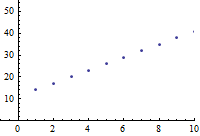
We use MathJax
Given a sequence described by a list of numbers, often having a formula for the sequence will be useful. Keep in mind, though, that many different formulas are possible for the same few initial terms of the list. However, certain patterns result in simpler formulas than other patterns, and it is these simple patterns that we generally seek.
Consider the sequence $14, 17, 20, 23, 26, 29, 32, \ldots$ Upon inspection, we might notice that consecutive terms are always the same distance from one another. This can be seen more clearly if we write the differences in a row underneath the spaces between the terms, as in the following diagram
\begin{equation*} \begin{array}{ccccccccc} 14, & \phantom. & 17, & \phantom. & 20, & \phantom. & 23, & \phantom. & 26,\ldots \\ \phantom. & +3 & \phantom. & +3 & \phantom. & +3 & \phantom. & +3 & \phantom. \end{array} \end{equation*}Whenever the consecutive terms of a sequence differ by a constant, the sequence is called an arithmetic sequence. The difference between consecutive terms is called the common difference, and is often identified by the variable $d$.
In our specific example, the common difference $d=3$. This pattern immediately implies that the recursive formula is $a_n=a_{n-1}+3,\quad a_1=14$. Furthermore, we see that the second term was produced by adding three once, the third term was produced by adding three twice, and in general the $n$th term is produced by adding three a total of $n-1$ times. Therefore, the explicit formula is $a_n=14+3(n-1)$, or after simplifying, $a_n=3n+11$.

In general, the recursive formula of an arithmetic sequence always has the form $a_n=a_{n-1}+d$, and the explicit formula always has the form $a_n=a_1+d(n-1)$. In particular, the explicit formula of an arithmetic sequence will always be linear, as is illustrated in the graph of this arithmetic sequence above.
The arithmetic sequence is used in a variety of applications. Examples include:
Common differences are one of the two easiest situations. Another very common situation in a sequence is to have a common ratio. See the page Geometric Sequences for more information.